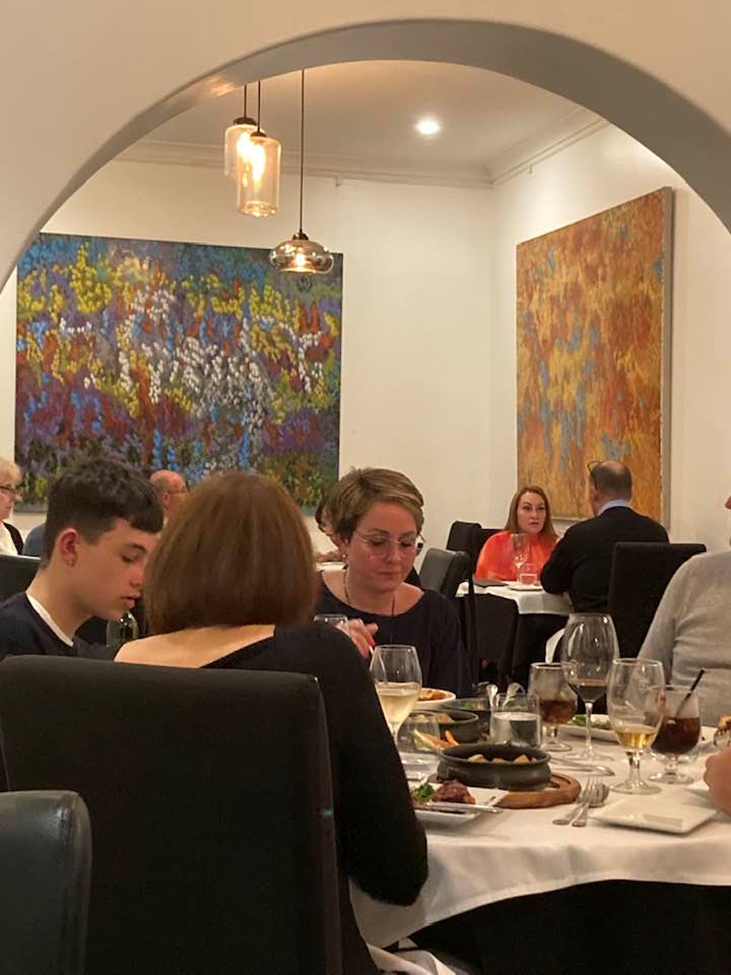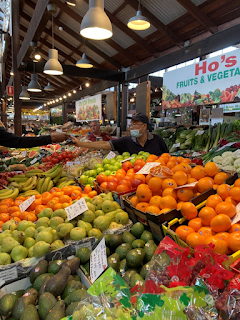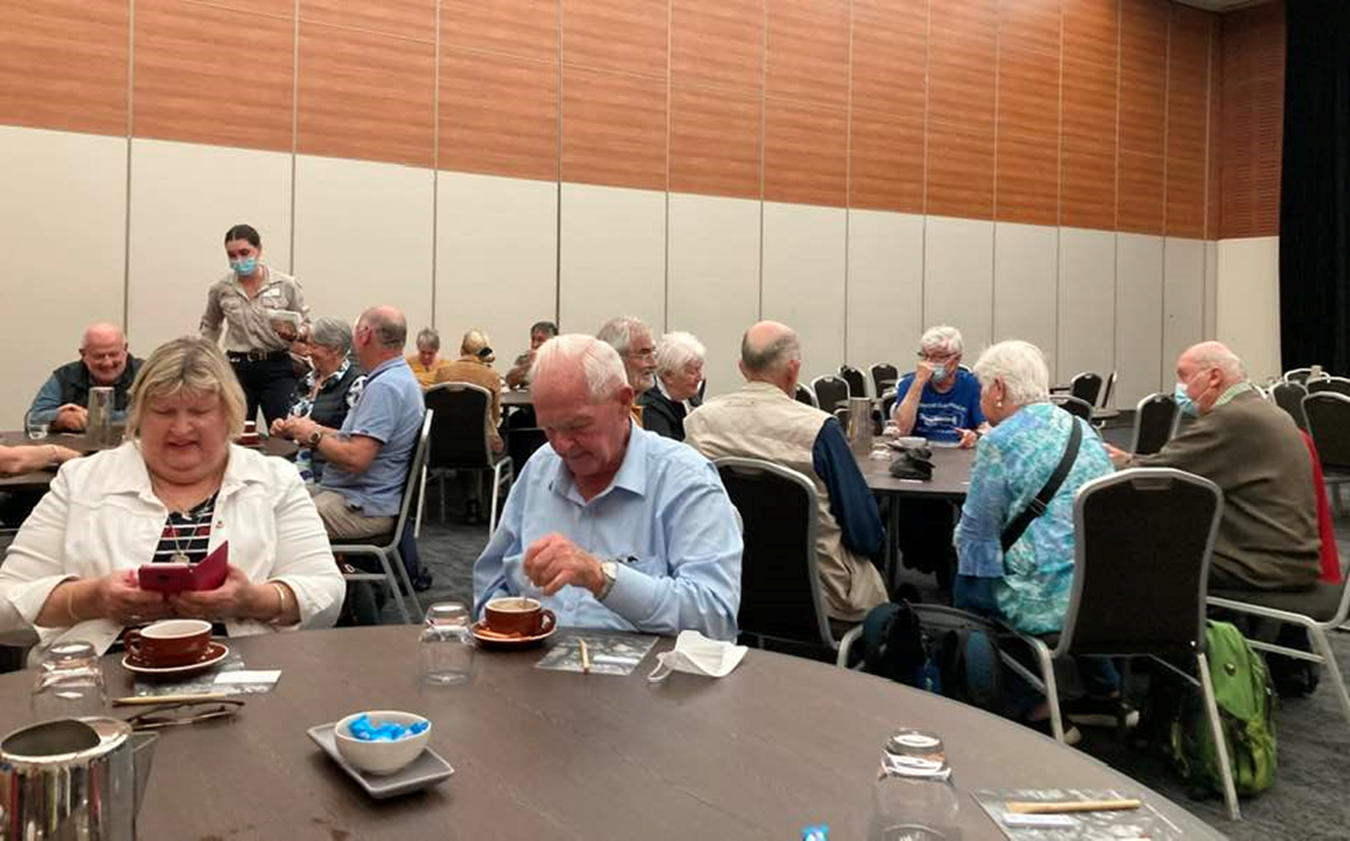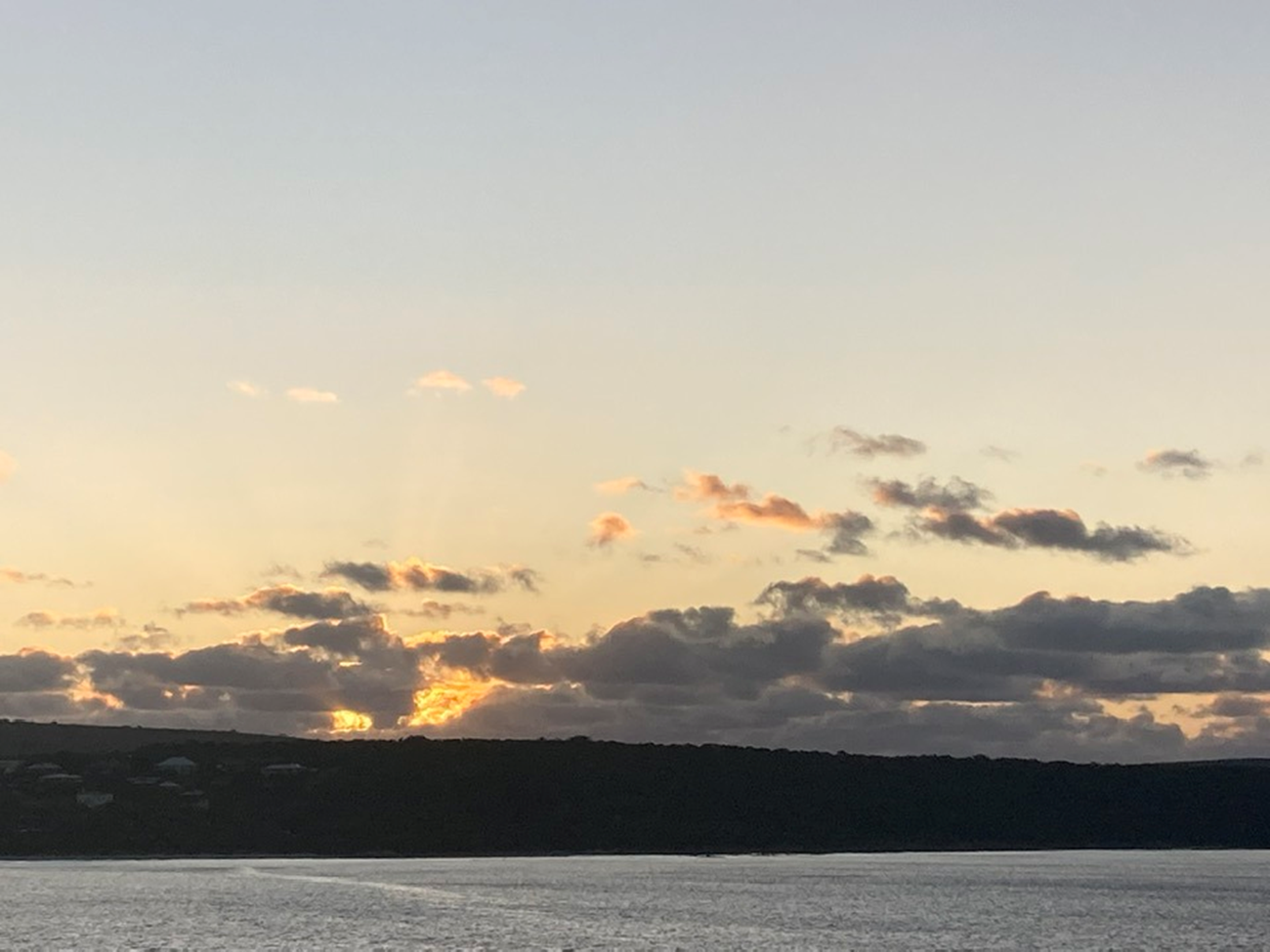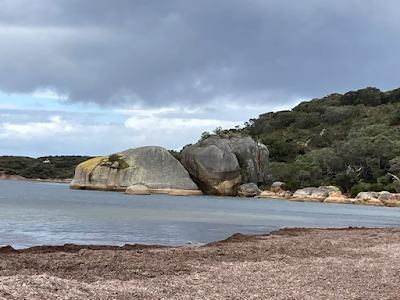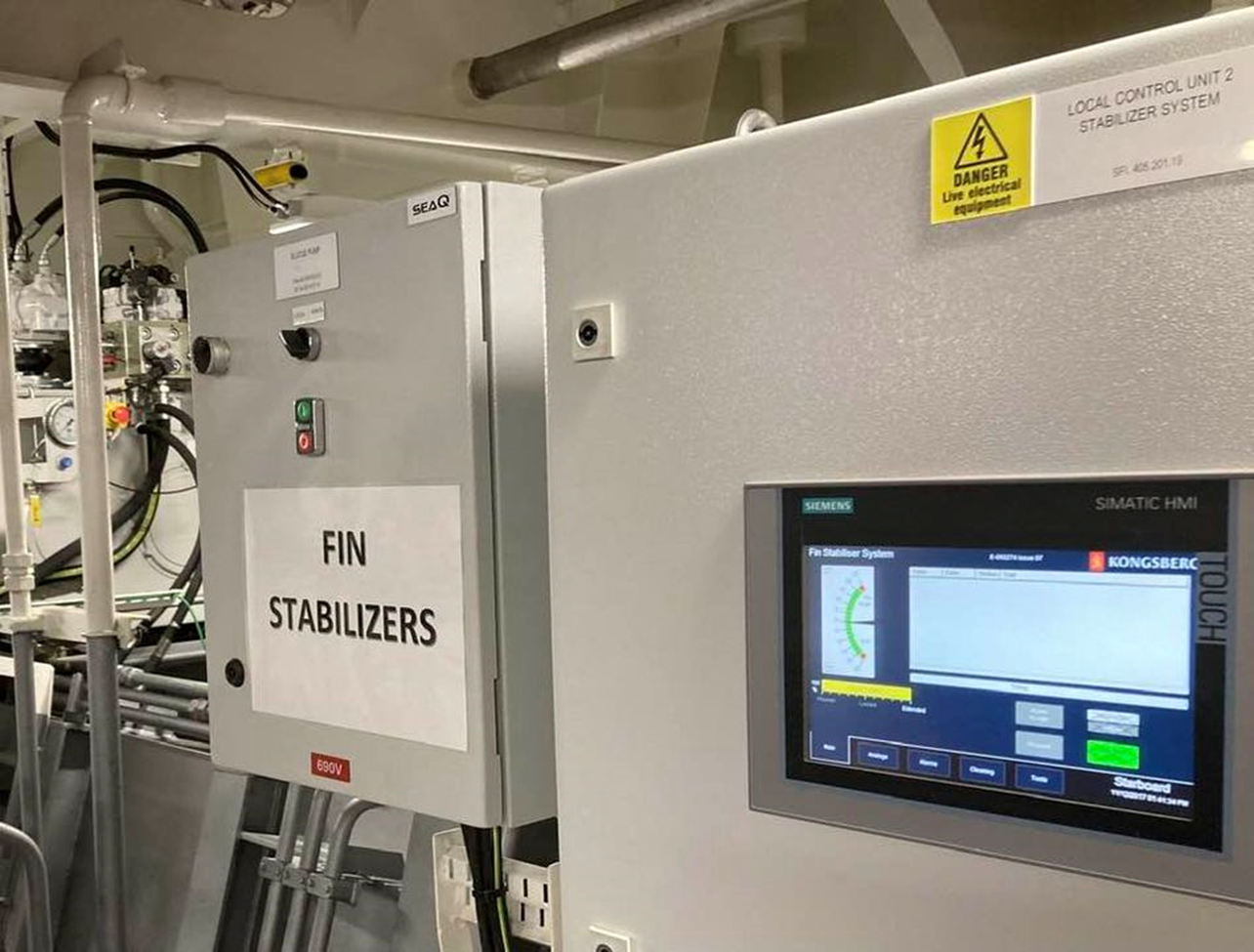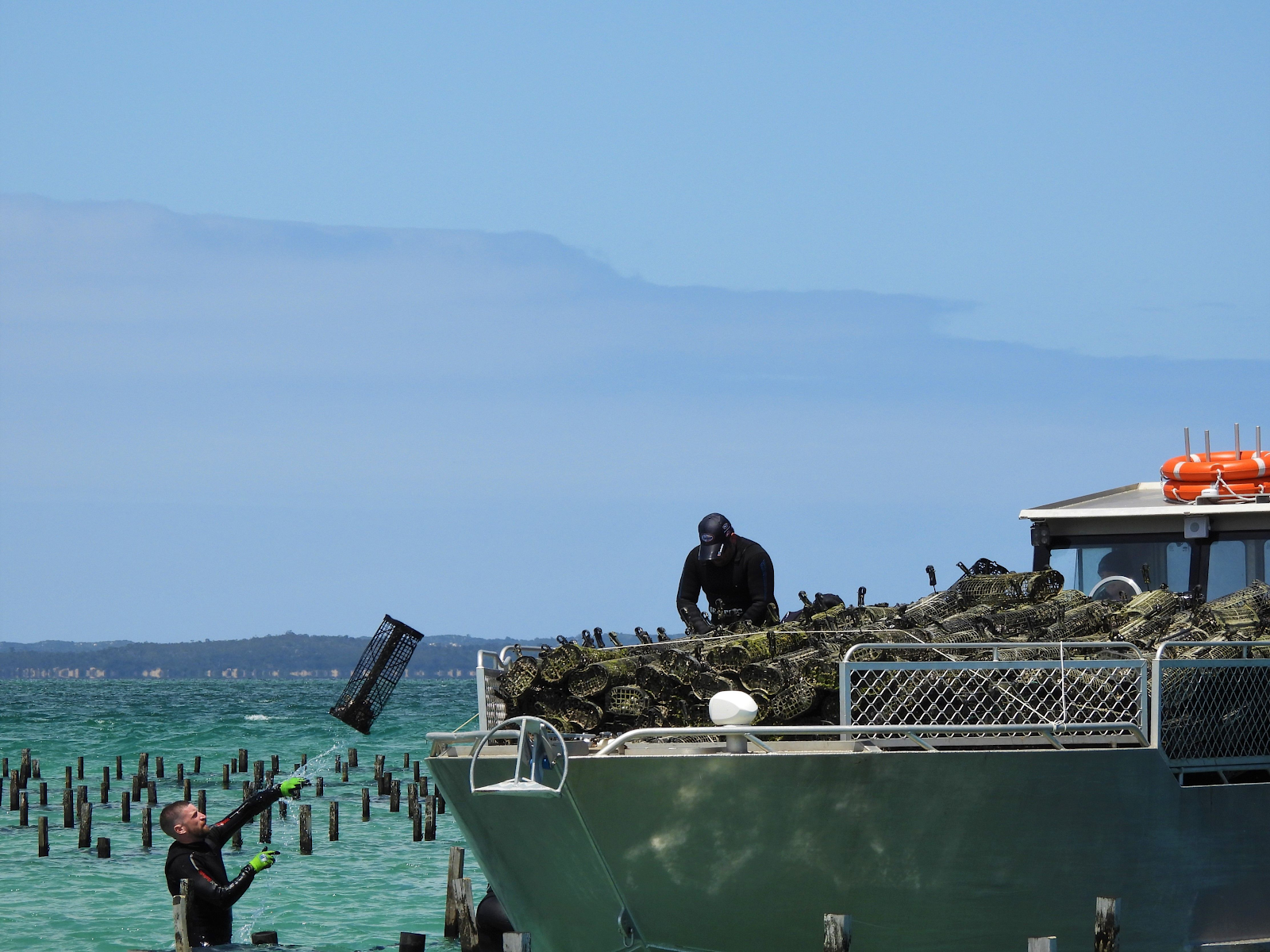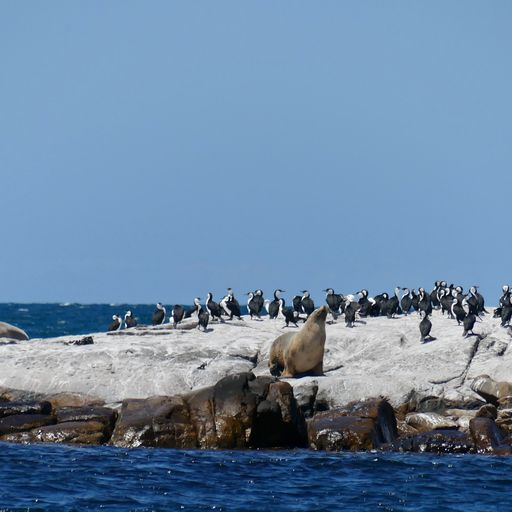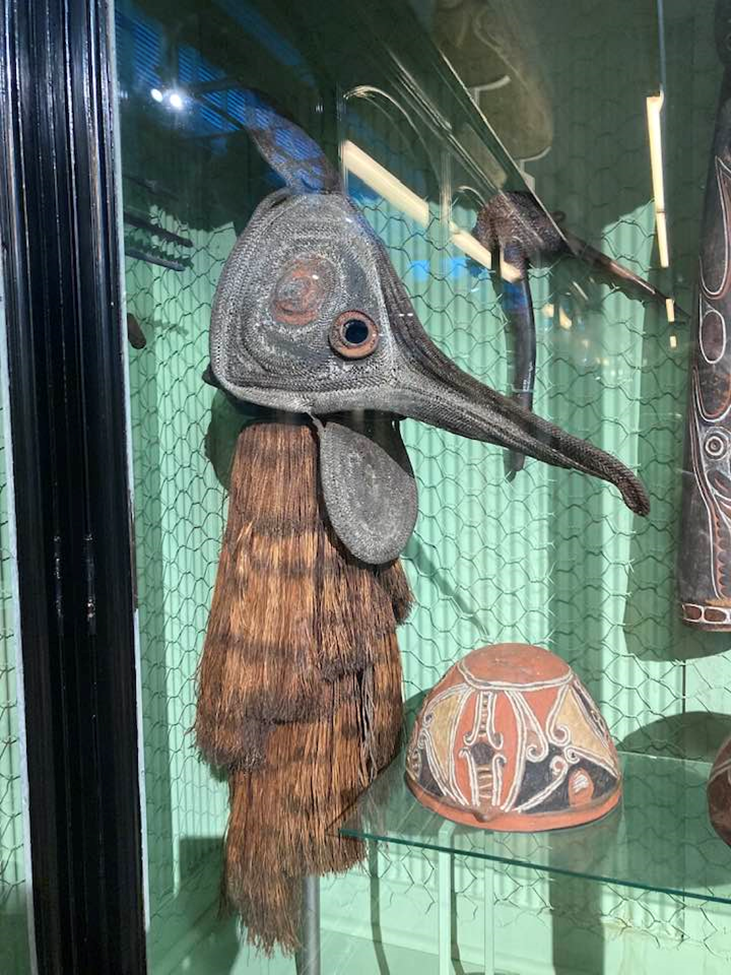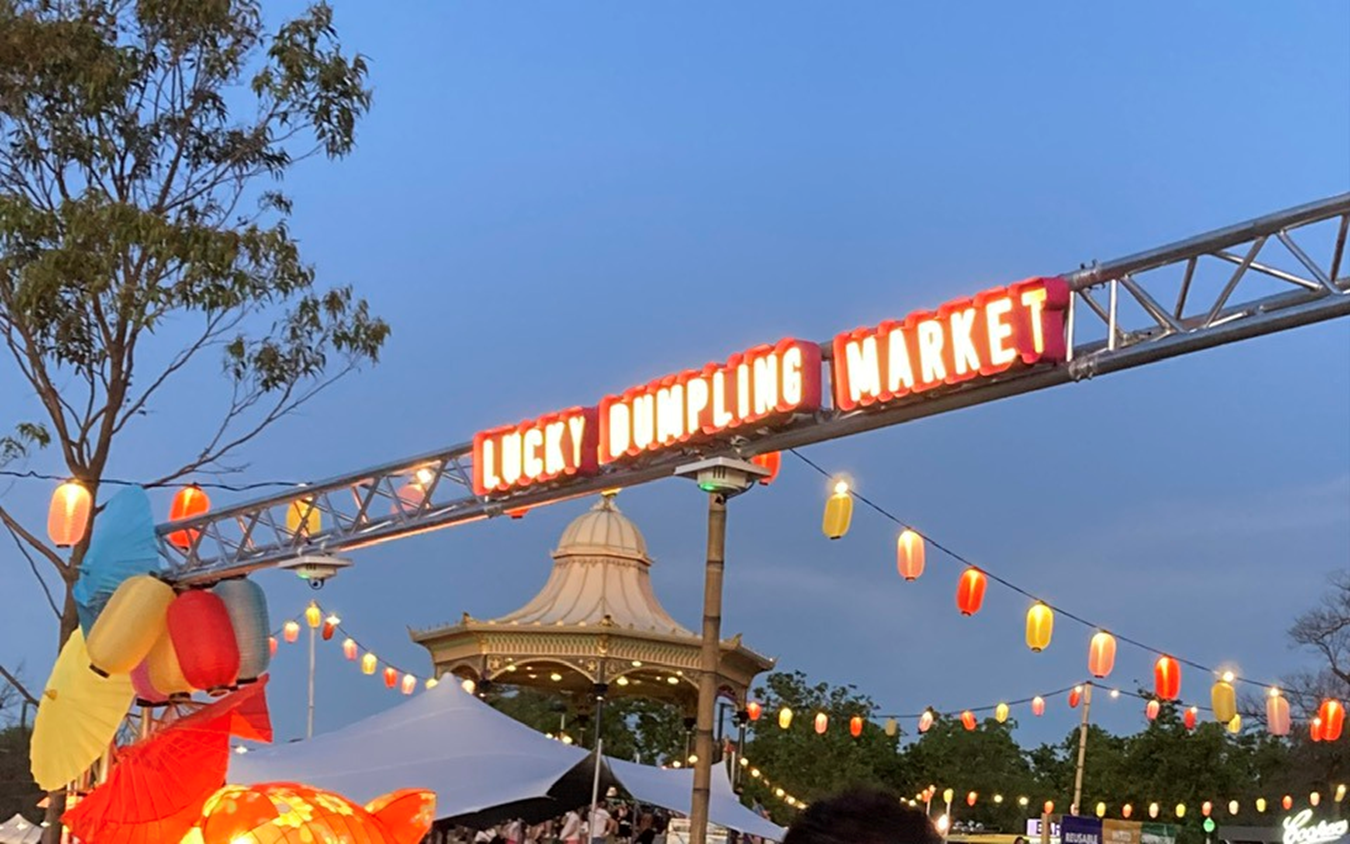AUSTRALIA: The Great Australian Bight, Covid, and making the best of a bad situation... Fremantle, Adelaide, Melbourne
I’d looked forward so very much to this geographic cruise on the Great Australian Bight with Coral Expeditions. I’d bracketed the cruise itself with some extra time up front in Fremantle/Perth (I think Western Australia is the best part of the country…) and then looked forward to taking the Ghan from Adelaide to Alice Springs and then on to Uluru to learn more about aboriginal culture. Finally, the plan was to end up in Sydney, taking in a performance at the Opera House and an afternoon cruise in Sydney Harbor. Alas, that was not all possible, due to catching Covid on the ship, being forced to isolate in my cabin for 5 days (maritime law), having a sore throat with the virus SO BAD that my right eardrum popped and the ear bled….so I didn’t exactly feel like the rigors of lots more travel in Australia after that. On the bright side, also known as the "every cloud has a silver lining" way of looking at life, my niece Margaret was visiting her friend Adrian in Melbourne, so I got to spend time with her, meet him, and enjoy Melbourne and environs from the perspective of a resident there. Overall, not the best trip of my lifetime, for sure. But, in the tradition of my usual bloggings, here we go…
So here we go!
Next stop, Sydney Australia.
October 20 - on to Fremantle (the port city of Perth!), also known as FREO
Oh gosh, another
five hours flight time from Sydney to Perth in western Australia, on top of the
16 1/2 hours from San Francisco to Sydney… Yes, I’m pretty tired. But my
experience of both these Australian airports is that they are spacious, clean,
filled with interesting shops, a lot of coffee bars, and terrific graphics.
This wall-sized graphic in the baggage claim area in Perth shows a quokka,
beckoning travelers to take the short boat trip from Perth’s port city,
Fremantle, over to the island. (I’m not going there this trip, I went in 2018.
) The quokka are cute, very friendly
No trip is complete without a couple of posts that might fall into the category of “food porn.“ On Friday night, I walked a few minutes away from my hotel Rydges Esplanade, and treated myself to a marvelous dinner at Nunzios. A salad of rocket, walnuts and thin slices of Parmesan to begin, then the most tender and tasty chicken rotini I have ever had in my life, followed by a tart of mango, raspberry, and meringue. Speaking to Nunzio himself, he bemoaned the fact that he tried to retire, and turn his restaurant over to his kids, but then post pandemic, no one seems to want to work. Sound familiar?
In the vicinity
of the Fremantle market, lots to look at. Pippi Longstocking and I went
shopping at the IGA supermarket, and paused to remark on the number of cookie
types available, which I think they call “biscuits“ here, in the English
tradition. Then, we had an absolutely wonderful time at the huge Fremantle
information center that is sponsored by the city, and the tourism representative,
Jo, was simply fantastic. Jet lag is almost gone,so we’ve got a full day of
activities planned tomorrow! Snap to it Pippi, there’s so much to see and the
Aussies are so friendly!
The Fremantle
market building houses a variety of food stalls with cuisine from all over the
world. The Friday lunchtime scene was noisy, colorful and aromatic! There are
lots of artisan stalls too, selling garments, ceramics, aromatherapy products,
etc. Great fun to wander here!
Why eat a boring
hotel Buffet breakfast when you can walk four minutes to the food stalls at
Fremantle market? Having scoped out the market vendors yesterday, I chose to
have a ham, cheese, and mushroom crêpe for breakfast this morning. The place
was busy, and all of the stools at the counter were occupied with families and
children. The kids’ favorite: a Nutella and strawberry crêpe
October 21 - Little Creatures Brewery !
Fremantle is the
home of the modern day craft beer revolution in Australia. I was fortunate to
have a tour of Little Creatures Brewery, located at the Fremantle fishing boat
harbor, orchestrated by my friend Roslyn Stallard, who currently lives in
Fremantle and is an assistant brewmaster in this wonderful establishment. I met
Roslyn in 2018 when she was Purser on the train I took from Perth to Sydney,
the Indian Pacific. We struck up a friendship over our mutual admiration of
Pippi Longstocking, who came to meet Roslyn today, and have stayed in touch
ever since. When Roslyn left Great Southern Railways, the company which owns
the Indian Pacific and the Ghan trains, she studied the technical aspects of
brewing and was fortunate to find herself at this wonderful enterprise which is
known across Australia. I participated in a tasting of a variety of beer,
including some new styles which Little Creatures has introduced to the market.
Oct 21 ~ a bit of tourism in Fremantle!
Nightlife on the weekends in Fremantle really rocks! The streets are full of people of all ages, either dancing at one of the many outdoor night clubs, taking in a meal, or enjoying a pint of beer and a sausage roll at one of the many eating and drinking establishments.
October 22 - We get on the ship CORAL GEOGRAPHER
Farewell Fremantle and the lovely Esplanade hotel!
We (100 passengers) are all required to take a RAT (rapid antigen test) and mine was clear, yahoo! Waiting for the briefing on the 13 day naturalist cruise on the Coral Geographer ship that travels to Adelaide along the Great Australian Bight.
October 23 - Eagle Bay and Dunsborough
Overnight, our ship moved from Fremantle to Eagle Bay and Dunsborough in Wardandi Country. This was the scene that greeted us…yes, a bit cold and rainy but a beautiful rainbow.
Our group made two beach landings at Eagle Bay, and in the morning walked to the Cape Naturaliste Lighthouse, and then in the afternoon we visited the resort Village of Dunsborough. A bit of historical background about this area: in 1801 an expedition under the command of Captain Nicholas Baudin visited Geographe Bay. Many places along this coast are named in honor of his expedition of scientific discovery. Naturalist notes: this is one of Australia’s most diverse marine environments. As warm tropical waters of the Leeuwin current mingle with the cold waters of the Cape's current, you have high diversity of both fish and seagrass. Humpback and Southern Right whales migrate through this area, and there are resident seals and dolphins. And oh, by the way, this is how we get from our ship of 100 passengers, to remote beaches on the Great Australian Bight; it’s called a “tender” and is lowered from the side of our ship into the water, and can carry 40 passengers at a time..
Dateline Oct 25~ off the coast of Busselton in Geographe Bay
We are now near the Margaret River Region which is 2.5 hours by car to Perth: Well, as they sing in a famous Gilbert and Sullivan operetta, “here’s a how dee do.”
Our small ship, the Coral Geographer, holds 100 passengers, all of whom had to pass a negative Covid test before we were allowed on board in the port of Fremantle two days ago. Busselton is a town that is known primarily for its jetty, the construction of which began in 1865. At that time, it was a mere 161 meters (174 yards) , but sand drift resulted in an additional 131 m being added in 1875. Further extensions were made throughout the following 90 years, creating the remarkable 1.8 km (1.125 miles) jetty length. After more than a century of use and servicing over 5000 vessels, the Busselton jetty officially closed as a port in 1973. Still, our group was interested in taking our tender over to this jetty which is still operational, walking its length, and making a foray into the town to visit the steam engine museum.
“ Permission denied,“ said the Busselton Town Council. “Covid concerns.“ So we are re-organizing our day today, and I suppose this excess of caution cannot be faulted. The result is that we all had to take a rapid COVID test, which Australians refer to as a RAT, in order to set foot on the beach to walk to the buses for our afternoon excursion. During our breakfast today, I sat with some folks from Brisbane, who were talking about the steps the Australian government had taken during Covid, closing off the borders of the individual states, so even people who lived a few miles from one state border but worked in another could not travel that distance to work. They told the (true) story of a teenager who is a friend of one of these folks: the teen was fined AU$1600 for taking a driving lesson. So those of us in the USA who whined and moaned about the Covid restrictions here… We clearly have nothing to complain about. Having said that, it is important to know that everyone in this group complies with the regulation that when we are in public areas of this ship, we must wear a mask. (Good thing I packed a wardrobe of about 20 kn95 masks in different colors…the new reality…)
After all of those RAT tests, we took a bus for 80 minutes to Leeuwin Wine Estates, an impressive property that's part of the Margaret River wine region. Nice wines, with the sommelier presenting them in a downstairs art gallery - and I particularly enjoyed the art showcasing frog designs: these were some innovative labels for the Rieslings!.
And here, on the wine estate grounds, was the famous kookaburra. Who knows the children’s song?
October 26 ~ It was a dark and stormy … day.
So it goes in southwestern Australia at this time of year, which is early Spring here.
The surf is up because there is a kind of nasty weather system we anticipate later today, so from the tender to the beach landing meant walking in a bit of water. Feet toweled off and walking shoes donned, our group got on a bus for 90 minutes and went to visit Two Oceans Abalone in Augusta. This enterprise, which recently went public as Ocean Grown Abalone Limited (trades as RFA on the Australian stock market), has developed a system of concrete artificial habitats of which 10,000 are now in place in a leased seabed plot 10 minutes by boat away from their processing facility. A team of 14 divers puts the baby Greenlip abalone into the habitats where they grow for 2-3 years before harvesting.
The company produces a full range of fresh, frozen, canned and retort-pouch (shelf stable) products that are sold at wholesale and retail to many markets primarily in Asia-Pacific. It’s a luxury product and it’s doing well; it’s reputation as an aphrodisiac no doubt helps, but like many mollusks it is high in protein and low in fat. (I got a shelf stable pack which I ended up gifting to Adrian in Melbourne...)
Our second excursion of the day was to the Cape Leeuwin Lighthouse in August. This is the tallest lighthouse on mainland Australia.
October 27 : Two People's Bay nature reserve.
This nature conservancy was preserved due to the discovery of the Noisy scrub bird, and also a rare marsupial, the Gilberts potoroo. Ancestors of the Noongar aboriginal people settled in the southwest Australia at least 20,000 years ago. During warm seasons, a community of Noongars known as the Minang, lived along the south west coast including the Two Peoples Bay area. In wInters they moved in land to hunt kangaroo. Aboriginal people called this area Yilbering. Today it’s known as Two Peoples Bay, the English meaning of the name given to the bay about 200 years ago during the chance meeting of two ships, one from France, and one from America. There was whaling in this area, but the aboriginal peoples also collected bloodroot plant for roasting.
Sunset drinks on the beach at Two Peoples Bay….chilly but beautiful.
October 28 - Breaksea Island and Cheynes Beach
This is not really the lighthouse tour of Southwest Australia, but it seems that everywhere we go, there is one present.
Today we began by taking a cruise around Breaksea island, an important haul-out for Antarctic Fur seals, Australian sea lions, and New Zealand Fur seals.
We saw an Australian sea lion barking at a fur seal to move so he could have that rock to himself. Later, we saw another fur seal haul himself out of the waters and then thermoregulate himself in the surf by rolling over and over; fur seals have many strands of hair growing from each follicle, so they get overheated when they sun on the rocks. This island was named in 1791 by George Vancouver, an English explorer. He named the island after its weather beaten appearance and the protection it offered to the landward side from the south-westerly winds. The geology here is beautiful, and the waters are cold.
Our last activity on a October 28 was to land at a beach near the port of Albany. Cheynes Beach was a gorgeous and expansive white sand beach. We could kayak, beach comb, or swim… But although those waters are crystal clear, they are still cold at this time of year. It is a favorite place for holiday homes, and easy to understand why.
Come with me on a Photo tour of the engine rooms of the Coral Geographer. This ship, which carries 120 passengers, was put into service last year, in 2021. It was built in Vietnam, at a cost of $75 million. The electronics are incredible, from the way that waste water and garbage is handled, to emergency braking systems, to the fuel system – – it runs on diesel – – and the miles and miles of pipes and the hundreds of controls.
October 29 - Cape Le Grand National Park and Lucky Bay
Cape Le Grand National Park is dominated by massive granite peaks, rolling heathlands, and curving white beaches. This is said to be some of the most spectacular landscape scenery along the southern coast of Australia, and the beach has been proclaimed the whitest sand beach in Australia. The waters are crystal clear and turquoise, and Lucky Bay where we had an excursion off the ship, is known for its friendly kangaroos on the beach (too cold for them today…).
It was named Lucky Bay when explorer Matthew Flinders in 1802 sailed a dangerous route through the Recherche Archipelago. His vessel HMS investigator took shelter in this bay during a summer storm. On board his ship was the botanist Robert Brown, who went to ashore and discovered diverse and largely unknown flora; he named many new species which he discovered there.
October 29 - COVID update. This morning we had two people who left the ship, both of whom tested positive this morning. Since we are soon sailing into the Southern Sea/Great Australian Bight, there won’t be any nearby medical facilities for quite a few days. We do have a nurse on board, but no Paxlovid. The captain just informed us at noon that there are two other cabins in isolation, containing three passengers. In my observation, the Australians are considerably more lax about Covid isolation etc than are those of us in the USA who take it seriously. I am sure I will have some haters for having said this, but it is simply my observation. As for me, I intend to double up my vigilance regarding social distancing; I have been masking in public areas and even during the indoor evening drinks events, and I will continue to do that.
… it was a dark and stormy afternoon… But here we are, off the ship, trying to avoid the raindrops and see a bit of Woody Island. The Recherche Archipelago is a group of 105 islands and many rocky out crops. Woody Island has stands of tall trees, which have given it its name. This is one of the few islands in the archipelago with pockets of deep soil and that soil supports strands of tall trees. Other islands only feature low, woody vegetation and a few are clothed in colorful herb fields. For bird lovers, a wide variety of bird life can be seen on the island (so I’ve been told, but even the birds are hiding from the driving rain).
For many thousands of years aboriginal people have occupied this region, entering and gathering with the diverse coastal resources. Esperance Nyungar people still live here and tell their Dreaming stories, which describe the origin and diversity of the granite peaks another local landscape features. Oh yes, I forgot, but on a pleasant warm day you can snorkel and swim In the waters off the visitor center.
One of the terrific things about the 3 ships in the Coral Expedition fleet is that they all have an “open bridge“ policy. Unless the captain is doing some kind of tricky maneuver into a port, any passenger can go to the bridge at any time and get an explanation of the instrumentation and the current sailing situation. That’s what I did today, so I could better understand this weather system that has beset the Great Australian Bight. If you can read charts, you’ll have a field day with these. If you cannot, the short explanation is that for the next three days there’s going to be rain and sea swells possibly as high as 12 feet as we proceed towards our final port of Adelaide to arrive next Saturday. So, there won’t be much to report on for a few days, my dear Facebook friends.
Oct 30 - At anchor off Middle Island in the Recherchre Archipelago
Sunday October 30 (Australian time) - our ship is at anchor off the waters of Middle Island in the Recherchre Archipelago. We’re waiting here until 10 PM before we haul anchor and proceed, so the worst of the weather system will have passed further east and then we will be on our way for three days at sea.
Explorer Matthew Flinders visited Middle Island in the early
1800’s and in 1803 named a small pink lake – – saturated with salt – – after a
crewmember of his ship The Investigator. Hillier Lake is located in the north-eastern
part of Middle Island; Middle Island is the largest of a group of three islands
that lie in the Spencer Gulf within the south western coast of the Yorke
Peninsula. It is currently a protected fauna conservation reserve and those of
our passengers who visited the island had to scrub their boots’ bottoms clean
so as not to bring any foreign organisms to this nature reserve, in particular
the organism which causes what is called “die back“ disease.
On other scores, our ship has now moved into a
Covid situation which is called “Amber“, which means minimized room cleaning
particularly of bedding, and the bridge will now be closed for passenger
visits. I will do a rapid test tomorrow morning, but I think I’m clear. What a
bother this virus is! Still, I’m glad I’ve had my five shots so far.
Well... this was not
good. An announcement came in mid afternoon on the ship's public address system from the captain that everybody must sit
down because “we just lost one of our fins.“ I wondered what that meant…. We are
still in the southern ocean, with a day and a half to go before the next port.
Well, just before we lost the fin, which we didn’t actually lose in the ocean - it is simply that the swells are so large that the power could not keep up with the demands to stabilize the ship. So right now we are pretty much rocking and rolling and the ship is heading away from the mainland and further out to sea where the swells are going to be less of a concern.
This area is
part of the Great Australian Bight Marine Park which is an area of global
importance for endangered southern right whales. These waters also support
important populations of the endangered Australian sea lion, with up to 80% of
that population found here. The seals haul out at the base of the cliffs, but
we are not going anywhere near those cliffs and can’t see that happen. I must
say, it’s pretty bouncy right now.
MORE ABOUT THE
NULLARBOR AND THE FAMOUS LIMESTONE CLIFFS…
The cliffs are
comprised of sediments made largely from calcium carbonate. Deposition of the
sentiments took place approximately 40 million years ago to 10 million years
ago. There were three separate episodes of marine, limestone deposition, which
can be seen in this photo. the top of each layer shows a period where the
surface was above sea level for a time, those layers were eroded before the sea
level rose again, and then limestone deposition began once again.
The Bunda cliffs section is 210 kilometers long ( 130 miles).
I really wanted
to see this close-up, but the weather system and swells in the ocean meant that
we really couldn’t get anywhere close. This is the best photo I could take from my
cabin…
The Bunda Cliffs, which are about 350 feet high rise straight out of the water as though someone had come and simply cut the Australian landmass off. This area is part of the Great Australian Bight Marine Park which is an area of global importance for endangered southern right whales. These waters also support important populations of the endangered Australian sea lion, with up to 80% of that population found here. The seals haul out at the base of the cliffs, but we are not going anywhere near those cliffs and can’t see that happen. I must say, it’s pretty bouncy right now.
BUT Every cloud has
a rainbow lining, at least here in the Southern Sea/Great Australian Bight.
October 31 ~ So Covid has caught up with me here in Australia.
For the next five days I’m confined to my ships cabin, which is not so dreadful because meals are delivered in the hallway on trays , a purser in a hazmat suit comes to pick up garbage and empty plates, and I now have been given my very own tea kettle so I can make Hot beverages anytime of the day or night. My main symptom is a bad sore throat, the kind that makes your ears hurt, but that is getting better. The protocol here in Australia is to isolate for five days, and then take a test. If the symptoms are gone, even if the test is still positive, then you’re free to go. That 5 days includes the next 3 days at sea (nothing much to see but the horizon and a lot of wave activity) takes me up to our morning landing on Saturday in Adelaide. Sadly, I will miss some of those coastal excursions I’d been looking forward to but I just might hang around Adelaide for a few days and figure out a way to see the nearby coast on my own. I’ve decided not to go on to the Outback, because there are smoky fires there, and temperatures are predicted to be in the high 90s. Not my favorite kind of weather. So, I’ll be back in the states earlier than I planned, and that’s OK. I am one of the few people on this expedition ship who is traveling solo, and I normally don’t mind that. But in this instance, I sure wish I had my family and friends closer at hand. The ship gave me unlimited Wi-Fi access, and that was useful to cancel my ongoing plans....
AND HERE IS WHAT I MISSED IN MY LOCK-DOWN ISOLATED CABIN....
These are the notes from the “Great Southern Gazette,” a one-pager put on my breakfast tray each morning during my isolation. Always a thrill to get a knock on the door from the staff, which knock announced that my food was on a cafeteria tray set on the corridor floor in front of my cabin. If I was really quick to put on my mask and open the door, I could see the staff fleeing down the corridor….
October
31, Day at Sea. Wind 30 knots, Swell:
5-6 meters.
The Southern Ocean, also known as the Antarctic Ocean, comprises the
Southernmost waters of the word.
Generally taken to be 60 degrees S latitude and encircling Antarctica,
it is regarded as the second smallest of the five principal oceanic divisions. It has a maximum depth of 7434 meters.
November
1 – Day at Sea - Wind: 25 Knots; Swell:
6-7 meters. (Doggone bouncy!)
Exploration
of the Southern Ocean was inspired by a belief in the existence of a Terra Australis
– a vast continent in the far south of the globe to “balance” the northern
lands of Eurasia and North Africa – which belief had existed since the times of
Ptolemy. The rounding of the Cape of
Good Hope in 1487 by Bartolomeu Dias first brough explorers with touch of the
Antarctic cold and proved that there was an ocean separating Africa from any
Antarctic land that might exist.
November
2 – Day at Sea – Wind: 15 knots; Swell:
4 meters.
The
Great Australian Bight was first encountered by European explorers in 1627 when
Dutch navigator Francois Thijssen sailed along its western margins. The coast was later first accurately charted
by the English navigator Matthew Flinders in 1802, during his circumnavigation
of the Australian continents. A later
land-based survey was accomplished the the English explorer Edward John
Eyre.
The Nullarbor
Plain borders much of the length of the Bight’s coastline. It is an ancient seabed, uplifted during the
Miocene era. Consisting of limestone, it
is flat and has an arid climate with very little rainfall. Water drains off the plain via a karst
system through cave formations in the underlying limestone. North of the Nullarbor lies the Great
Victoria Desert, which has an internal drainage system terminating in numerous
small salt lakes.
November 3 – Coffin Bay, Seasick Bay and Oyster Tour/Tasting
British
naval explorer Matthew Flinders named the bay on February 16, 1802, in honor of
his friend Sir Isaac Coffin, who was Resident Naval Commissioner at Sheerness,
where the ship The Investigator as fitted out.
The bay remained uncharted until explored in 1839 by Captain Frederick
Lees, in command of the brig Neureus.
Lees’ thorough charts became a standard reference for mariners from that
time until today’s electronic era.
Coffin
Bay beach landing, and exploration of the
impressive sand dunes.
Excursion: Coffin
Bay Oyster Tour & Tasting ( I
wasn’t unhappy to miss that, as I dislike oysters. Slimmy).
Beach landing at
Seasick Bay. Walks, sand dunes.
November
4 – Cape Donington. Low winds, swell of only one meter, sunny for
a change….
Cape
Donington is a headland in the Australian state of South Australia located at
the most northerly part of the Jussieu Peninsula on the east coast of Eyre
Peninsula and is about 10 kilometers east of the city of Port Lincoln. It was named by the Royal Navy office Matthew
Flinders in 1802, reported after Flinders’ native village in Lincolnshire,
UK. The land around Cape Donington was first
used for agricultural purposes in 1875.
A navigation aid consisting of a light was installed in 1905 and
subsequently replaced by a lighthouse.
(Another lighthouse!)
On the northern
point of Cape Donington is a small rocky island that’s known to be a
popular seal haulout site. The plan was
to cruise around the island to have a close-up experience with this
wildlife.
November 5 - Get off the ship!
A last beautiful sunset on the evening of November 4,
Today, November 5, finally the ship pulled
into Adelaide port. After all the other passengers left, we 10 COVID cases were
one by one mustered off the ship, helped with our suitcases down a quarter mile
long road where everything was sprayed with one last round of sanitizer before
we each got in a taxi. Solo. As in solitary. Like “Solitary Confinement”. Well
THAT’S over! But it does arouse sympathy in me for those workers from Foxconn
who jumped over the compounds chain link fences to get away from Chinese
lockdowns last week.
Nov 5- So time to move on!
After putting my luggage into the hotel and
doing a load of laundry (remember – there were no services like this available
on the cruise after it went into Amber Covid phase…), I grabbed a quick lunch
and then spent a few hours at The Museum of South Australia -what a marvelous
museum that is! I’m going back tomorrow. My feet hurt, because for six days the
only walking I’ve been able to do is back-and-forth across my cabin; the ship
crew would not even let us out into the hallways. Well, I’m glad that’s over.
I spent a couple hours at the museum in the mineral, explorer, and Pacific islands collections. I was interested to see a Spirit Mask like one I brought back from the Sepik River region of Papua New Guinea in 2001. Lots to see but I decided to break my visit into two half-days
I walked over to the hopping “east end” on the shopping street called Rundle Mall, although it is not a mall in the way we think of one, but rather blocks and blocks of shops.
There I had a gelato and talked with a brother and sister who were walking their lucky dogs (which dogs each had a small cup of vanilla gelato) and they told me to go tonight to a food festival called the Oz Asia festival, where there are dance performances and lots of food choices. So after I put my feet up for a little bit, I went.
Scenes from the
Oz–Asian Festival, held at Elder Park near the Adelaide convention center.
Lots of food booths from cuisines of Asia, hundreds of people milling around or
sitting at picnic tables and blankets on the ground, lots of interesting
singers … all to be enjoyed on a beautiful Spring night in Adelaide.
November
6 – more of Adelaide and back to the museum
Adelaide has a
very lively street art scene, encouraged by the city managers. I like the idea
that vacant store fronts are used as canvases; it eliminates the shabby aspects
of a town center. And then, of course, in the busy East End section, art takes
a life form with bridesmaids nights out… That must be a universal event!
On this trip to the museum, I focused on
indigenous cultures. The Australian
Aboriginal Cultures Gallery features over 3000 items across two floors. Pieces of material culture are from
communities across Australia. As the
museum’s website notes, over 65,000 years, Australia’s Aboriginal people have
successfully innovated and developed creative ways of life in one of the world’s
harshest continents. You can see boomerangs,
bark paintings, shields, maps, early recordings, photographs, field notebooks
and more. A particular attraction is the
Yendemu school doors.
“These doors represent one of the earliest
examples of Aboriginal artists successfully transferring their ancient ground
paintings to a large-scale modern medium,” according to the museum. “At Yeundumu in the 1980’s, five artists were
responsible for 27 Dreaming designs on the school doors; they represent more than 200 sites in the
Waripiri and Anmatyerre territory. The doors were intended to remind the schoolchildren
of sites and obligations extending across their country.” The doors remained a Yuendumu for 12 years
and were transferred to the museum in 2011 after extensive conservation efforts
to clean them after the years of being subjected to desert wind and sun.
The state library of South Australia, located in Adelaide next to that fantastic museum, is really not to be missed, even just for only a five minute walk around. I could not figure out why everybody was recommending a quick visit , until I went myself. It is a beautiful facility, as you see from the photos below. But an equally interesting thing is that one of the security guards to whom I’d asked a question, talked to me for about 15 minutes on my way out, and told me how concerned he is about the state of politics in the USA. The world is watching, and the prognosis seems not to be all that positive. Sad.
November 7 – flight to Melbourne
It’s been 8 days since the onset of my Covid, I’m
feeling good, and I took JetStar on it’s short flight to Melbourne. JetStar was good enough to let me switch my
ticket from Uluru-Sydney, and use the value for that flight. Terrific service! And in retrospect, I’m glad I didn’t go to
Uluru… look at the weather forecast for my planned time there! Hot hot hot!
In Melbourne I stayed at the Sofitel on Collins
Street, which is one of the nicest hotels I have ever experienced! Gorgeous interior, great service, beautiful
room overlooking downtown Melbourne.
I met my niece Margaret and her friend Adrian
for a fantastic seafood meal at a nearby restaurant. I was quite surprised to see the Christmas
decorations already up in Melbourne – but then, the Aussies do not have a Thanksgiving
celebration to get in the way of an early start to the Christmas/Holiday
season.
Adrian was nice enough to drive us there, although
the immense rains they had recently experienced in the Melbourne area meant
that some direct routes were closed. So
we ambled on some longer roads which gave us an overview of the Yarra Valley.
A stop at the “dairy” enterprise allowed a tasting of local cheeses. Really yummy! Don’t miss an excursion like that. And then a quick stop at a winery for a tasting….(no pix of that, sorry…)
Afterwards, Adrian stopped at a small field
near his home in the suburbs of Melbourne.
What a joy to watch the kangaroos jumping around freely! And so close to an urban area too!
November 9 – tour of Melbourne’s
Museum and some shopping.
The Melbourne Museum has it all. It’s an all-around natural history and
cultural history museum, with everything from dinosaur bones to regalia and
items from the establishment of Australia.
In the Melbourne Gallery of the museum, which tells the story of Melbourne, there is a life-size display of the Commonwealth Coat of Arms of Australia (above) The shield, which depicts Australia’s 6 states, is held up by the native Australian animals the kangaroo and the emu, which were chosen to symbolize a nation moving forward, based on the fact that neither animal can move backwards easily. A seven-point gold Commonwealth Star sits above the shield. The seven-pointed Commonwealth Star on top of theg the crest also represents the states and territories.
November 10 - homeward bound!
Pippi Longstocking and I say farewell to Australia on November 10. But first we stopped to admire the highly decorated pandas in the corridor on the way to our United flight, which is nonstop from Melbourne to San Francisco. Finally, today, on day 12 after my first Covid symptoms, I have tested negative. Covid put a crimp in my plans, and I canceled my planned trip to Ayer’s Rock/Uluru, and to Sydney. But it’s OK, I can always return!


